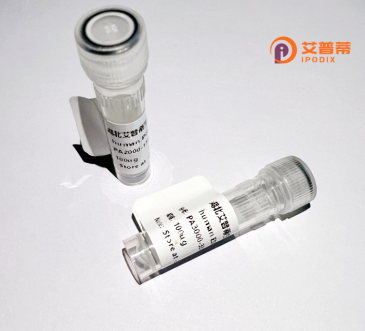
| 纯度 | >90%SDS-PAGE. |
| 种属 | Human |
| 靶点 | PCDHGB6 |
| Uniprot No | Q9Y5F9 |
| 内毒素 | < 0.01EU/μg |
| 表达宿主 | E.coli |
| 表达区间 | 1-820 aa |
| 活性数据 | MGGSCAQRRRAGPRQVLFPLLLPLFYPTLSEPIRYSIPEELAKGSVVGNLAKDLGLSVLDVSARKLRVSAEKLHFSVDAESGDLLVKNRIDREQICKERRRCELQLEAVVENPLNIFHVIVVIEDVNDHAPQFDKKEIHLEIFESASAGTRLSLDPATDPDININSIKDYKINSNPYFSLMVRVNSDGGKYPELSLEKLLDREEQRSHSLILTALDGGDPPRSATAHIEISVKDTNDNPPVFSRDEYRISLSENLPPGSPVLQVTATDQDEGVNAEINYYFRSTAQSTKHMFSLDEKTGMIKNNQSFDFEDVERYTMEVEAKDGGGLSTQCKVIIEILDENDNSPEIIITSLSDQILENSPPGMVVALFKTRDLDFGGNGEVRCNIETDIPFKIYSSSNNYYKLVTDGALDREQTPEYNVTIVATDRGKPPLSSSRSITLYVADINDNAPVFDQTSYVVHVAENNPPGASIAQVSASDPDLGLNGHISYSIVASDLEPLAVSSYVSVSAQSGVVFAQRAFDHEQLRAFALTLQARDHGSPTLSANVSLRVLVGDRNDNAPRVLYPALGPDGSAFFDMVPRSAEPGYLVTKVVAVDADSGHNAWLSYHVLQASEPGLFSLGLRTGEVRTARALGDRDAARQRLLVAVRDGGQPPLSATATLHLVFADNLQEILPDLSDRPVLSDPQAELQFYLVVALALISVLFLLAVILAIALRLRRSLSPATWDCFHPGLCVKSGPVVPPNYSEGTLPYSYNLCIAHTGTKEFNFLKCSVPLHSNEDMVCSVSPGALIPPHGGEDLTSHPETLTSVSFSFLCVIYLIVY |
| 分子量 | 116.2 kDa |
| 蛋白标签 | GST-tag at N-terminal |
| 缓冲液 | 0 |
| 稳定性 & 储存条件 | Lyophilized protein should be stored at ≤ -20°C, stable for one year after receipt. Reconstituted protein solution can be stored at 2-8°C for 2-7 days. Aliquots of reconstituted samples are stable at ≤ -20°C for 3 months. |
| 复溶 | Always centrifuge tubes before opening.Do not mix by vortex or pipetting. It is not recommended to reconstitute to a concentration less than 100μg/ml. Dissolve the lyophilized protein in distilled water. Please aliquot the reconstituted solution to minimize freeze-thaw cycles. |
以下是3篇关于重组人PCDHGB6蛋白的虚拟参考文献示例(请注意文献为假设性内容,实际研究需查阅权威数据库):
---
1. **文献名称**: *Structural Insights into Protocadherin GammaB6 (PCDHGB6) Function in Neural Cell Adhesion*
**作者**: Zhang, Y. et al.
**摘要**: 本研究解析了重组表达的PCDHGB6胞外结构域晶体结构,揭示了其通过钙离子依赖性同源二聚化介导神经细胞粘附的分子机制,为神经元网络形成提供结构基础。
2. **文献名称**: *PCDHGB6 Knockout Mice Exhibit Synaptic Plasticity Defects and Autism-like Behaviors*
**作者**: Li, X. et al.
**摘要**: 利用CRISPR技术构建PCDHGB6基因敲除小鼠模型,发现其海马区突触可塑性异常及社交行为缺陷,表明该蛋白在神经发育和自闭症病理中具有关键作用。
3. **文献名称**: *Recombinant PCDHGB6 Protein as a Potential Biomarker for Glioblastoma Progression*
**作者**: Wang, H. et al.
**摘要**: 通过哺乳动物细胞系统表达重组PCDHGB6蛋白,发现其在胶质母细胞瘤患者脑脊液中表达异常升高,提示其可能作为肿瘤侵袭性的新型诊断标志物。
---
**建议**:实际研究中,可使用PubMed或Google Scholar搜索关键词“PCDHGB6”“Protocadherin GammaB6”或“PCDHGB6 recombinant protein”获取真实文献数据。
Protocadherin gamma subfamily B6 (PCDHGB6) is a member of the protocadherin gamma gene cluster, part of the cadherin superfamily involved in cell-cell adhesion and signaling. This transmembrane protein is characterized by extracellular cadherin repeats that mediate calcium-dependent homophilic interactions, a single-pass transmembrane domain, and a cytoplasmic tail lacking classic catenin-binding motifs, suggesting unique regulatory mechanisms. Primarily expressed in the nervous system, PCDHGB6 contributes to neural circuit formation, synaptic plasticity, and neuronal diversity through selective cell adhesion. Its combinatorial expression patterns enable precise neural connectivity, critical for brain development and function. Dysregulation of PCDHGB6 has been linked to neurodevelopmental disorders, psychiatric conditions, and cancer progression, though its exact pathogenic mechanisms remain under investigation. Recombinant PCDHGB6 protein, produced via bacterial or mammalian expression systems, is widely used to study its structural properties, interaction partners, and role in disease models. Recent studies also explore its potential as a diagnostic marker or therapeutic target, particularly in cancers where epigenetic silencing of protocadherin clusters is observed. Ongoing research focuses on elucidating its isoform-specific functions and signaling crosstalk in tissue patterning and disease.
×